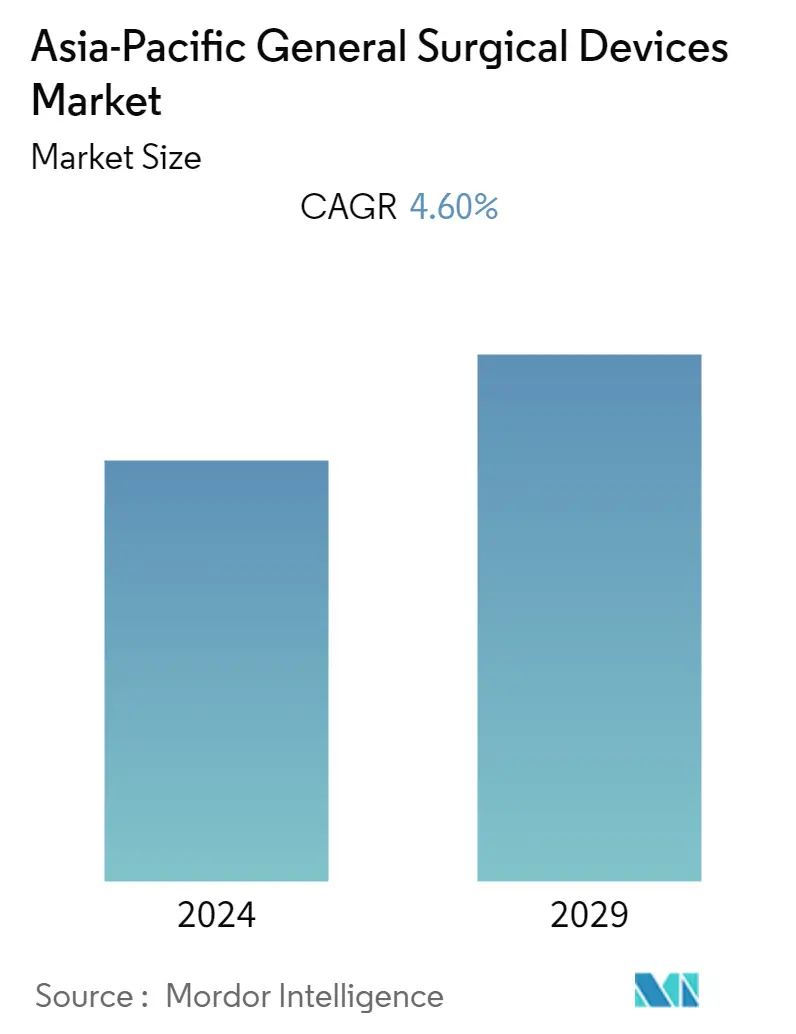Market Size of Asia-Pacific General Surgical Devices Industry

| Study Period | 2019 - 2029 |
| Base Year For Estimation | 2023 |
| Forecast Data Period | 2024 - 2029 |
| Historical Data Period | 2019 - 2022 |
| CAGR | 4.60 % |
Major Players
*Disclaimer: Major Players sorted in no particular order |
APAC General Surgical Devices Market Analysis
The Asia-Pacific market for general surgical devices is expected to register a CAGR of 4.6% during the forecast period.
COVID-19 had a significant impact on the Asia-Pacific market for general surgical devices in the initial phases, as the surgeries and procedures were delayed due to global lockdowns. However, with the easing of restrictions, the industry rebounded strongly. Over the previous two years, the market recovery has been led by increased sales of surgical devices, new product launches, and a high prevalence of injuries and accidents.
Factors such as the increasing demand for minimally invasive devices, cases of injuries and accidents, and healthcare expenditures in emerging economies are boosting the market's growth. For instance, as per the 2021 report published by the NCRB, Government of India, traffic accidents resulted in injuries to 3,73,884 persons in 2021. Furthermore, as per the WHS Statistics Australia 2022 report, 52,316 traumatic joint/ligament and muscle/tendon injuries were recorded in Australia in 2021. The main reason for injury hospitalization in Australia was found to be an accident or fall. Hence, considering the growing cases of injuries and accidents, the market for general surgical devices is expected to grow significantly.
The increasing healthcare expenditures in emerging economies and the adoption of minimally invasive devices for surgery are promoting market growth. For instance, per the Parliament of Australia 2022 update, the total spending on healthcare in 2022-23 is estimated at USD 105.8 billion, representing 16.8% of the Australian government's total expenditure. Moreover, as per the India Union Budget 2022-2023, the government allocated INR 86,200 crores (about USD 10.6 million) to the Ministry of Health and Family Welfare, a nearly 16.5% increase in comparison to INR 73,932 crores (about USD 10.4 billion) in 2021 driven by increased allocation to centrally sponsored public health schemes to continue building sustainable healthcare infrastructure and ensure system preparedness to handle the increasing healthcare needs of the country. Such increased healthcare expenditure and funding are expected to boost market growth over the forecast period.
For instance, the growing burden of chronic diseases, along with the rising geriatric population, is likely to lead to increased demand for general surgical devices. Spending on healthcare in Asian countries is also expected to increase during the forecast period. For instance, according to the e-Stat, in Japan, households spent an average of around JPY 15,162 (USD 102.03) on medical treatments in 2022. Thus, the growing burden of diseases is expected to increase the demand for general surgical devices during the forecast period.
Hence, as per the factors mentioned above, the market studied is likely to witness growth over the forecast period. However, stringent government regulations and improper reimbursement for surgical devices restrain the market growth.
APAC General Surgical Devices Industry Segmentation
As per the scope, surgical devices serve a specific purpose during surgery. Surgical devices have generic use, while some specific tools are designed for particular procedures or surgeries. The Asia-Pacific market for general surgical devices is segmented by Product (Handheld Devices, Laparoscopic Devices, Electrosurgical Devices, Wound Closure Devices, Trocars and Access Devices, and Other Products), Application (Gynecology and Urology, Cardiology, Orthopedic, Neurology, and Other Applications), and Geography (China, Japan, India, Australia, South Korea, and the rest of Asia-pacific). The report offers the value (in USD million) for the above segments.
| By Product | |
| Handheld Devices | |
| Laparoscopic Devices | |
| Electro Surgical Devices | |
| Wound Closure Devices | |
| Trocars and Access Devices | |
| Other Products |
| By Application | |
| Gynecology and Urology | |
| Cardiology | |
| Orthopedic | |
| Neurology | |
| Other Applications |
| Geography | |
| China | |
| Japan | |
| India | |
| Australia | |
| South Korea | |
| Rest of Asia-Pacific |
Asia-Pacific General Surgical Devices Market Size Summary
The Asia-Pacific general surgical devices market is poised for growth, driven by a resurgence in surgical procedures following the initial disruptions caused by the COVID-19 pandemic. The market is experiencing a robust recovery, fueled by increased sales of surgical devices, new product launches, and a high incidence of injuries and accidents. The demand for minimally invasive devices is on the rise, supported by higher healthcare expenditures in emerging economies. This trend is particularly evident in countries like India and Australia, where significant investments in healthcare infrastructure and public health schemes are being made. The growing burden of chronic diseases and an aging population are further propelling the demand for general surgical devices, as more surgeries are required to address these health challenges.
The market landscape is characterized by a competitive environment with numerous players, both international and local, contributing to the fragmented nature of the market. Companies such as B. Braun Melsungen AG, Boston Scientific Corporation, Conmed Corporation, Medtronic PLC, and Johnson & Johnson are key players in this space. The introduction of advanced devices, such as robotic hand-held surgical instruments, is enhancing surgical precision and efficiency, thereby boosting market growth. Additionally, the increasing number of outpatient surgeries and the adoption of innovative surgical technologies are expected to drive the market forward. Despite the positive outlook, challenges such as stringent government regulations and reimbursement issues remain, potentially hindering market expansion.
Asia-Pacific General Surgical Devices Market Size - Table of Contents
-
1. MARKET DYNAMICS
-
1.1 Market Overview
-
1.2 Market Drivers
-
1.2.1 Rising Demand for Minimally Invasive Devices
-
1.2.2 Growing Cases of Injuries and Accidents
-
1.2.3 Increasing Healthcare Expenditures in Emerging Economies
-
-
1.3 Market Restraints
-
1.3.1 Stringent Government Regulations
-
1.3.2 Improper Reimbursement for Surgical Devices
-
-
1.4 Porter Five Forces
-
1.4.1 Threat of New Entrants
-
1.4.2 Bargaining Power of Buyers/Consumers
-
1.4.3 Bargaining Power of Suppliers
-
1.4.4 Threat of Substitute Products
-
1.4.5 Intensity of Competitive Rivalry
-
-
-
2. MARKET SEGMENTATION (Market Size by Value - USD Million)
-
2.1 By Product
-
2.1.1 Handheld Devices
-
2.1.2 Laparoscopic Devices
-
2.1.3 Electro Surgical Devices
-
2.1.4 Wound Closure Devices
-
2.1.5 Trocars and Access Devices
-
2.1.6 Other Products
-
-
2.2 By Application
-
2.2.1 Gynecology and Urology
-
2.2.2 Cardiology
-
2.2.3 Orthopedic
-
2.2.4 Neurology
-
2.2.5 Other Applications
-
-
2.3 Geography
-
2.3.1 China
-
2.3.2 Japan
-
2.3.3 India
-
2.3.4 Australia
-
2.3.5 South Korea
-
2.3.6 Rest of Asia-Pacific
-
-
Asia-Pacific General Surgical Devices Market Size FAQs
What is the current Asia-Pacific General Surgical Devices Market size?
The Asia-Pacific General Surgical Devices Market is projected to register a CAGR of 4.60% during the forecast period (2024-2029)
Who are the key players in Asia-Pacific General Surgical Devices Market?
Boston Scientific Corporation, Johnson & Johnson, Medtronic PLC, B. Braun Melsungen AG and Conmed Corporation are the major companies operating in the Asia-Pacific General Surgical Devices Market.

